Pow wow
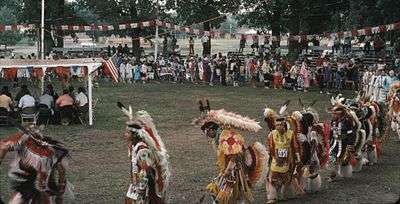
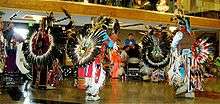
A pow wow (also powwow or pow-wow) is a social gathering held by many different Native American communities. The word derives from the Narragansett word powwaw, meaning "spiritual leader".[1] A similar gathering by California Native People usually in the fall is called a Big Time. A modern pow wow is a specific type of event for Native American/First Nations people to meet and dance, sing, socialize, and honor their cultures. Pow wows may be private or public. There is generally a dancing competition, often with significant prize money awarded. Pow wows vary in length from a one-day event, to major pow wows called for a special occasion which can be up to one week long.
In popular culture, such as older Western movies, the term has also been used by non-Natives to describe any gathering of Native Americans, or to refer to any type of meeting among non-Natives (such as military personnel). However, such use may be viewed as cultural appropriation, and disrespectful to Native peoples.[2]
Organization
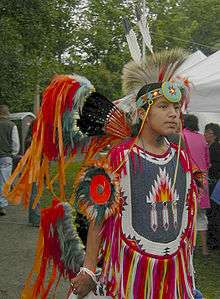
Planning for a pow wow generally begins months, perhaps even a year, in advance of the event by a group of people usually referred to as a pow wow committee. Pow wows may be sponsored by a tribal organization, by an American Native community within an urban area, a Native American Studies program or American Native club on a college or university campus, tribe, or any other organization that can provide startup funds, insurance, and volunteer workers.
Pow wow committee
A pow wow committee consists of a number of individuals who do all the planning prior to the event. If a pow wow has a sponsor, such as a tribe, college, or organization, many or all members of the committee may come from that group. The committee is responsible to recruit and hire the head staff, publicize the pow wow, secure a location, and recruit vendors who pay for the right to set up and sell food or merchandise at the pow wow.
Staff

The head staff of a pow wow are the people who run the event on the day or days it actually occurs. They are generally hired by the pow wow committee several months in advance, as the quality of the head staff can affect attendance.[3] To be chosen as part of the head staff is an honor, showing respect for the person's skills or dedication.
Arena director
The arena director is the person in charge during the pow wow. Sometimes the arena director is referred to as the whip man, sometimes the whip man is the arena director's assistant, and many pow wows don't have a whip man. The arena director makes sure dancers are dancing during the pow wow and that the drum groups know what type of song to sing. If there are contests the arena director is ultimately responsible for providing judges, though he often has another assistant who is the head judge. The arena director is also responsible for organizing any ceremonies that may be required during the pow wow, such as when an eagle feather is dropped, and others as required. One of the main duties of the arena director is to ensure that the dance arena is treated with the proper respect from visitors to the pow wow.

Master of ceremonies
The master of ceremonies, or MC, is the voice of the pow wow. It is his job to keep the singers, dancers, and public informed as to what is happening. The MC sets the schedule of events, and maintains the drum rotation, or order of when each drum group gets to sing. The MC is also responsible for filling any dead air time that may occur during the pow wow, often with jokes. The MC often runs any raffles or other contests that may happen during the pow wow.
Head dancers
The head dancers consist of the Head Man Dancer and the Head Woman Dancer, and often Head Teen Dancers, Head Little Boy and Girl Dancers, Head Golden Age Dancers, and a Head Gourd Dancer if the pow wow has a Gourd Dance. The head dancers lead the other dancers in the grand entry or parade of dancers that opens a pow wow. In many cases, the head dancers are also responsible for leading the dancers during songs, and often dancers will not enter the arena unless the head dancers are already out dancing.
Host drums and drum groups

Music for pow wow dance competition and other activities is provided by a "Drum," a group of performers who play a large, specially designed drum and sing traditional songs. The number of members of a drum group may vary, but is usually at least four people, and can be far more. Some members of the drum group may wear traditional regalia and dance as well as drum, other times drummers simply wear street clothing. Drums usually rotate the duty of providing songs for the dancers, each taking a turn at the direction of the pow-wow management.
The Host Drum of the pow wow is a drum group primarily responsible for providing music for the dancers to dance to. At an Intertribal pow wow, two or more drums are hired to be the host drums. In some places there is a Host Northern Drum and a Host Southern Drum. Depending on the size of the pow wow and the region where it is held, there may be many drums, representing nearly every tribe or community attending the pow wow. At some pow wows, the drums are judged on the quality of their performances, with prize money awarded to the winners.
Each drum has a Lead Singer who runs his or her drum and leads the singers while singing. Host drums are responsible for singing the songs at the beginning and end of a pow wow session, generally a starting song, the grand entry song, a flag song, and a veterans or victory song to start the pow-wow, and a flag song, retreat song and closing song to end the pow wow. Additionally, if a pow-wow has gourd dancing, the Southern Host Drum is often the drum that sings all the gourd songs, though another drum can perform them. The host drums are often called upon to sing special songs during the pow-wow.
Famous host drums include Black Lodge Singers, Cozad Singers, and Yellowhammer.
The event
Setup
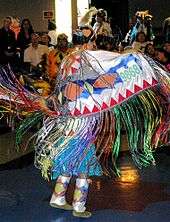
A pow wow is often set up as a series of large circles. The center circle is the dance arena, outside of which is a larger circle consisting of the MC's table, drum groups, and sitting areas for dancers and their families. Beyond these two circles for participants is an area for spectators, while outside of all are designated areas with vendor's booths, where one can buy food (including frybread and Indian tacos), music, jewelry, souvenirs, arts and crafts, beadwork, leather, and regalia supplies.[4]
At outdoor pow wows, this circle is often covered by either a committee-built arbor or tent, or each group, particularly the MC and the drums, will provide their own. While most of the time, a tent provides shelter from the sun, rain can also plague outdoor events. It is particularly important to protect the drums used by the drum groups, as they are sensitive to temperature changes and, if it rains, they cannot get wet. Most vendors provide their own tents or shelters at an outdoor pow wow.
Pow wow etiquette
Pow wow etiquette is required; such as rules for when photography is or is not acceptable, protocol for the Grand Entry, and so on. A few guidelines are common; clothing worn by participants is known as "regalia" and not to be called a "costume." Some rules are for common sense courtesy: drums have special rules and should not be touched or played by those not a part of the drum group. People and their regalia should not be touched without permission. However, details of pow wow etiquette vary from one geographic region to another.[5] Regardless of where the pow wow takes place geographically, when a person does not know the proper etiquette at that specific pow wow, it is best to remain quiet until there is a break and they can talk specifically to the staff or arena director.[6] Proper etiquette is important for not only those attending the pow wows but for performers as well. Many of these rules have been in place for hundreds of years and many are new. They are always in a constant state of modification. Some rules for common sense courtesy include, all singers and dancers who are under the influence of drugs while performing will be disqualified. For dancers, when a song is finished, both feet must be on the ground yet the body can be in any position. Dancers must be in full dress and prepared to start within ten minutes of grand entry time. Dancers also must always keep in time with the drum beat and bells must be worn at all times. All singers must be seated ten minutes before grand entry time and there should be no fewer than three singers per drum and no more than 10. The United Tribes Pow Wow in North Dakota have used these regulations and more, as they apply to dancers and singers.[7] As for other forms of etiquette, according to the Navajo tribe, it is important to follow basic protocols that one would abide by when visiting a Native American Reservation. This includes understanding that if a person is visiting a reservation, they are a guest. If a person is not enrolled in a reservation, they have no legal right to be there. At a pow wow, one must be respectful in order to be able to stay. Photographs are also a big part of reservation etiquette. Depending on the reservation and ceremony, viewers should ask before taking photographs or recording videos or tapes. Some tribes, such as the Pascua Yaqui and Hopi, ban photos and sketches of ceremonies. When attending a pow wow, in order to be truly respectful, asking direct and specific questions is the best way to learn exactly how to have correct etiquette. Also, those who attend pow wows should dress modestly as to not disrupt hosts in traditional reservations where modesty is the custom.[8]
Opening

A pow-wow session begins with the Grand Entry and, in most cases, a prayer. The Eagle Staff leads the Grand Entry, followed by flags, then the dancers, while one of the host drums sings an opening song. This event is sacred in nature; some pow wows do not allow filming or photography during this time, though others allow it.
If military veterans or active duty soldiers are present, they often carry the flags and eagle staffs. They are followed by the head dancers, then the remaining dancers usually enter the arena in a specific order: Men's Traditional, Men's Grass Dance, Men's Fancy, Women's Traditional, Women's Jingle, and Women's Fancy. Teens and small children then follow in the same order. Following the Grand Entry, the MC will invite a respected member of the community to give an invocation. The host drum that did not sing the Grand Entry song will then sing a Flag Song, followed by a Victory or Veterans' Song, during which the flags and staffs are posted at the MC's table.
Dances
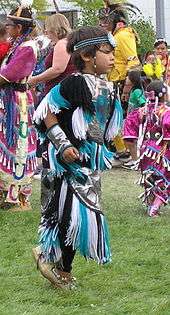
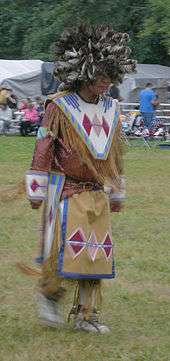
Most of the various types of dances performed at a pow wow are descended from the dances of the Plains tribes of Canada and the United States. Besides those for the opening and closing of a pow wow session, the most common is the intertribal, where a Drum will sing a song and anyone who wants to can come and dance. Similar dances are the round dance; crow hop when performed by a northern drum or a horse stealing song by a southern drum; there is also "double beat", "sneakup" and, for Women's Traditional and Jingle, "sidestep". Each of these songs have a different step to be used during them, but are open for dancers of any style.
In addition to the open dances, contest dances for a particular style and age group are often held, with the top winners receiving a cash prize. To compete in a contest, the dancer must be in regalia appropriate for the competition. Larger pow wows have more specific categories. The dance categories vary somewhat by region, but general categories are as follows:[9]
Men's dances
- Fancy Dance or Fancy Feather Dance (Northern and Southern styles): A dance featuring vivid regalia with dramatic movement, including spins and leaps. Often the biggest crowd-pleasing competition of a pow wow. Aside from bright color and non-traditional materials, fancy dancers are also distinguished by use of a two-bustle design on their regalia. There are two styles of the roach: In the North, it is the same as the grass dance roach, in the South, the roaches have rockers, two feathers on springs that rock back and forth.
- Northern Traditional (simply "Men's Traditional" in the North): A dance featuring traditional regalia, authentic design and materials, single or no bustle, and movements based on traditional dances.
- Straight dance (or Southern traditional): Straight dancers usually are more neat and with more homemade features such as chokers, breastplates, etc. Their dances are like Northern, They take one foot and step on the ball of their foot and then they tap it once on the ground. Then they tap it once again but this time they put their heel a few milimeters above the ground and repeat the process with the other foot. They do this in a walking motion. it is very hard especially if you have to follow the beat of fast drums. If they catch themselves off beat they will tap their foot three times instead of two to get back with the drums' rhythm.
- Grass Dance: A dance featuring regalia with long, flowing fringe and designs remniscent of grass blowing in the wind. Dance movements are more elaborate than the traditional dancers, but less flashy than the fancy dancers.
Eastern War Dance : A dance from the East Coast that is a storytelling dance, Men wear no bustle however do carry a fan and dance stick. This is also called the "Eastern Strait Dance".
Women's dances
- Traditional (seen at Northern pow wows): A dance featuring traditional regalia of cloth or leather, featuring authentic design and materials, and dancers who perform, with precise, highly controlled movement.
- Buckskin and Cloth: A traditional dance from the South. The name refers to the type of material of which the dress is made. The regalia is similar to the Northern traditional dance. However, in the South, buckskin and cloth dancers are judged in two separate categories. The dance steps are the same for both regalia categories.
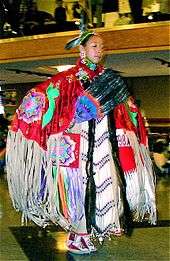
- Fancy Shawl: A dance featuring women wearing brilliant colors, a long, usually fringed and decorated, shawl, performing rapid spins and elaborate dance steps.
- Jingle Dress (healing dance):The jingle dress includes a skirt with hundreds of small tin cones that make noise as the dancer moves with light footwork danced close to ground.
Normal intertribal dancing is an individual activity, but there are also couples and group dances. Couples dances include the two step and owl dance. In a two step each couple follows the lead of the head dancers, forming a line behind them, whereas in an owl dance each couple dances alone. Group dances include the Snake and Buffalo dance, where the group dances to mimic the motions of a snake in the beginning of the dance, then change to mimic the actions of a herd of buffalo.
At pow wows where there is a large Southern Plains community in the area, the Gourd Dance is often included before the start of the pow wow sessions. The gourd dance originated with the Kiowa tribe, whence it spread, and is a society dance for veterans and their families. Unlike other dances, the gourd dance is normally performed with the drum in the center of the dance arena, not on the side.
Music
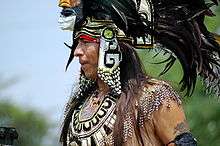
Pow wow music is the Native American drumming, singing, and dancing performed at pow wows. Though there are many genres unique to different tribes pow wow music is characterized by pan or intertribalism with the Plains cultures, the originators of the modern pow-wow, predominating. For information on dancing, see Dances.
Drumming
- "Good drums get the dancers out there, good songs get them to dance well. Without drum groups there is no music. No music, no dance, no powwow."[10]
There may be many drums at a pow wow, especially weekend or week long ones, but each pow wow features a host drum which is accorded great respect and the most authority. The members of drum groups are often family, extended family, or friends. Groups are then often named for families, geographic locations, tribal societies, or more colorful names. Many groups display their names on jackets, caps, vehicles, and chairs. Traditionally only men would drum and women would sit behind the men singing high harmonies. Beginning in the mid-1970s, women began drumming with men and seconding, or singing, an octave higher, the song.[11] Today, there are mixed-gender and all-female drum groups.
The supplies a drum group carries include the drum, rawhide headed, a cloth bag for padded drum sticks, the drum stand, folding chairs for sitting, and, in some cases, a public address system. The drum head, stand, microphone stands, and PA box are often decorated with paintings or eagle feathers, fur, flags, and strips of colored cloth.[12]
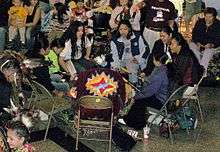
Readily noticeable in performances are the "hard beats" used to indicate sections of the song. The "traditional method" consists of a pronounced strike by all singers every other beat. These may appear in the first or second line of a song, the end of a section, before the repetition of a song. A cluster of three hard beats (on consecutive beats) may be used at the end of a series of hard beats, while a few beats in the first line of a song indicate performer enthusiasm. In the "Hot Five" method five beats are used, with the first hard beat four beats before the second, after which the beats alternate.[13]
Drum etiquette
To understand drum protocol, a drum may be thought of as a person or being and is to be regarded and respected as such. Drum etiquette is highly important. There are regional variations. The drum is the central symbol of Oklahoma pow wows and is located in the center of the dance floor and pow wow (which are themselves shaped in concentric circles). Southern drums are suspended by four posts, one for each direction. Northern drums are set up on the outside of the dance area, with the host drum in the best position. Drummer-singers are expected to remain at their drum and ready to sing at any moment's notice; a dancer might approach the drum and whistle, fan or gesture his staff over a drum to indicate his request for a song even if it is not that drum group's turn to sing. In some regions it is considered disrespectful to leave a drum completely unattended. Some drum groups do not allow females to sit down at their drum but welcome them to stand behind the drummers and sing backup harmonies; the reasons for this point vaguely to a variety of tribal stories that attempt to tell the history of drumming as each group understands it. People bring water to the drummers and generally assist the players as needed. (It is also considered a taboo among some nations to discuss spiritual teachings in writing or to name absolute authority in reference to spiritual teachings.) The drum is offered gifts of tobacco during giveaways and musicians acknowledge this by standing.[14]
Singing
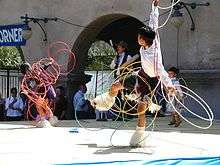
While the drum is central to pow wows, "the drum only helps them keep beat. Dancers key on the melody of the song. Rhythms, tones, pitch all help create their 'moves'." (p. 85) Note that Bill Runs Above did not mention the lyrics of the songs, and while they are no doubt important, most lyrics of most songs employ vocables, syllable sounds such as "ya", "hey", and "loi" (p. 86).[15] This is particularly evident in intertribal songs, such as the AIM Song, which cannot be biased towards a certain language.
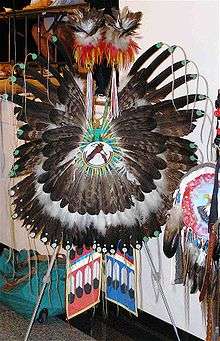
The song structure consists of four pushups, singing the chorus and verse through four times. In each chorus the melody is introduced or led off by the lead singer whose is then seconded by another singer who begins to vary the melody before the end of the leader's first line. They are then joined by the entire chorus for the rest of the pushup. Three down strokes or hard beats[16] mark the end of the chorus and beginning of the verse, and during these drummers while alter their dancing such as by hopping low like fancy dancers. An increase in tempo and volume on the last five beats marks the end of the final verse. The dancing stops on the final beat and then a tail, or coda, finishes the song with a shortened chorus.[17] Sometimes a drum group will sing the song more than four times, particularly when the song feels good and the singers seize the moment for an extra pushup or two (or more), or when a dancer blows a whistle or passes his staff or fan over the drum to signal that the song is to be continued four extra pushups while he prays.
Singing differs by region in that a high falsetto is used in the north while in the south a lower range is used. "To the unfamiliar listener, Indian singing sounds exotic, different, and difficult to comprehend," and the contrast in the quality or timbre of voice used in traditional Indian and European musics may have much to do with that difficulty. However, "to the trained ear, melodies flow, ascend and descend" while dancers react to changes in the structure of the melody and the song. Boye Ladd says, "If you give me a stink song, I'll dance stink. If you give me good music, I'll give you a great show," implying that one can appreciate the music through the dancing, which is readily appreciated by everyone.[17] But others say that today's contemporary contest dancers are expected to dance their best no matter how well or poor the drum group is that is singing for their contest. Generally, Native American singing follows a pentatonic scale (as if playing only the black keys on a piano) and while, to the outsider, it may sound like we're just pounding a drum and going "Heya-heya-heya-heya" sometimes there are actual words in Cree, Pikuni, Lushuutsid, Niimipuu, Lakhota, Sahpatin, Salish, Ojibwemowin or many other Native languages.
Talented singers also sing off-the-beat, placing the words between the drum beats rather than on them, which "is probably the non-Indian's greatest obstacle in trying to learn Indian songs."[18]
Genres and change
In the 1970s drums had begun incorporating native words in addition to vocables. Groups such as the Black Lodge Singers have released songs with English words, such as on their children's albums. Given the intertribal style of pow wow music it may be viewed as less traditional or valuable though the music is also used to support tribal identity and display the value of a living culture.
List of pow wows
The following is an incomplete list of notable pow wows, both ongoing and defunct:
- Crow Fair
- Long Plain First Nation Annual Pow-wow
- Gathering of Nations
- Celebration
- Bay Area American Indian Two Spirits (BAAITS) Pow Wow
See also
References
- ↑ O'Brien, Frank Waabu. "Chapter 10: Spirit Names and Religious Vocabulary". pp. entry # 12. Retrieved 20 July 2014.
- ↑ Sabine, Patricia (November 16, 2011). "Commentary - Did they really just say that?". Hanscom Air Force Base. Retrieved September 10, 2013.
- ↑ Chris Glazner, Roxanne Solis, and Geoff Weinman; Southern Native American Pow Wows; "The Arena and Staff"; url accessed April 20, 2006
- ↑ Becky Olvera Schultz (2001); Powwow Power; "What is a powwow and a brief history"; url accessed May 3, 2006
- ↑ "Powwow-Power.Com's Powwow Etiquette". Powwow-power.com. Retrieved 2013-09-10.
- ↑ austinisd.org. "Pow Wow Etiquette" (PDF). Austin Independent School District. Retrieved 20 November 2016.
- ↑ McCluskey, Murton. "Understanding and Enjoying Pow Wows" (PDF). Montana Office of Public Instruction. OPI MT. Retrieved 20 November 2016.
- ↑ Volante, Enric. "Respectful Ways go a Long Way on Arizona Indian Land". Navajo Central. Navajo Central. Retrieved 20 November 2016.
- ↑ Glazner, et al.; "Dance Styles"; url accessed April 20, 2006
- ↑ Roberts, Chris (1992). Powwow Country. ISBN 1-56037-025-4.
- ↑
- Roberts, Chris (1992). Powwow Country, p.85-89. ISBN 1-56037-025-4.
- ↑ Roberts, Chris (1992). Powwow Country, p.86 and 89. ISBN 1-56037-025-4.
- ↑ Hatton, O. Thomas (1974). "Performance Practices of Northern Plains Pow-Wow Singing Groups", Anuario Interamericano de Investigacion Musical, Vol. 10, pp. 129.
- ↑ Hatton, O. Thomas (1974). "Performance Practices of Northern Plains Pow-Wow Singing Groups", p.85-86, Anuario Interamericano de Investigacion Musical, Vol. 10, pp. 123-137.
- ↑
- Roberts, Chris (1992). Powwow Country, p.85-86. ISBN 1-56037-025-4.
- ↑ Nettl, Bruno (1989). Blackfoot Musical Thought: Comparative Perspectives. Ohio: The Kent State University Press. ISBN 0-87338-370-2.
- 1 2
- Roberts, Chris (1992). Powwow Country, p.86. ISBN 1-56037-025-4.
- ↑
- Hatton, O. Thomas (1974). "Performance Practices of Northern Plains Pow-Wow Singing Groups", p.128, Anuario Interamericano de Investigacion Musical, Vol. 10, pp. 123-137.
Works cited
- Hatton, O. Thomas (1974). "Performance Practices of Northern Plains Pow-Wow Singing Groups", Anuario Interamericano de Investigacion Musical, Vol. 10, pp. 123–137.
- Kyi-Yo (2007). Kyi-Yo Celebration. Kyi-Yo student organization, Native American studies, University of Montana.
- Nettl, Bruno (1989). Blackfoot Musical Thought: Comparative Perspectives. Ohio: The Kent State University Press. ISBN 0-87338-370-2.
- Roberts, Chris (1992). Powwow Country. ISBN 1-56037-025-4.
External links
| Wikimedia Commons has media related to Pow wows. |
- Powwow Calendar at Powwow-Powwow.com
- Powwow calendar at Powwows.com
- Library of Congress collection of Omaha Pow-wow music
- PowWow Radio 24/7 Free Internet Radio of Pow Wow Music
- Powwow Time Powwow calendar, photo gallery and information
- Denver March Powwow, Denver, Colorado (March)
- Gathering of Nations PowWow (link to Gathering of Nations website), University of New Mexico (April)
- Stanford Powwow, Stanford University, California (May)
- Schemitzun Feast of Green Corn and Dance, North Stonington, Connecticut (August)
- United Tribes International Powwow, United Tribes Technical College, North Dakota (September)
- Wacipi - Powwow Documentary produced by Twin Cities Public Television
- Pow-Wow Princess Song